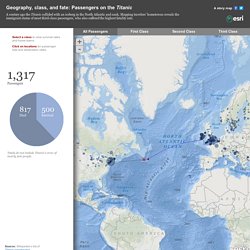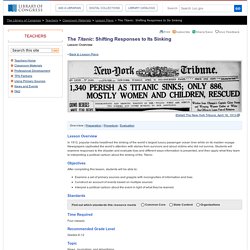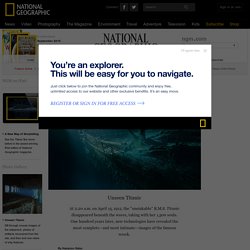

Titanic: Faces of the crew. Geography, class, and fate: Passengers on the Titanic. More than 2,200 people were on board the Titanic when it struck an iceberg the night of April 14, 1912.

The Titanic’s crew of nearly 900 is not included here. First class passengers hailed mainly from U.S. and European cities. Despite orders to put women and children in lifeboats first, survival rates were highest in first class. Most children were in steerage. Travelers in second class enjoyed fewer amenities aboard the Titanic. Immigrants comprised the bulk of steerage passengers, many of whom began their voyages in Ireland, Scandinavia, and Lebanon. More than 2,200 people were on board the Titanic when it struck an iceberg the night of April 14, 1912. First class passengers hailed mainly from U.S. and European cities.
Travelers in second class enjoyed fewer amenities aboard the Titanic. Immigrants comprised the bulk of steerage passengers, many of whom began their voyages in Ireland, Scandinavia, and Lebanon. A New Look at Nature’s Role in the Titanic’s Sinking. Setting the Stage for the Titanic Tragedy - Graphic. The Best Sites For Learning About The Titanic. Next month is the one hundredth anniversary of the sinking of the Titanic.

I’m sure tons of additional resources will come online between now and then, and I’ll keep on updating this list. But I figured it would be helpful to get started now. Here are my choices for The Best Sites For Learning About The Titanic: Ultimate Titanic is the place to start. It has tons of resources. Expedition Titanic is a neat interactive. The History Channel has a Titanic Interactive. The History Channel also has several video clips. Unseen Titanic - An Interactive Image Gallery. Homepage - AKO Titanic Trial. History - British History in depth: Titanic: Sinking the Myths. Lesson Plans - Sleuthing for a Lost Ship. Grades 6-8 Overview: In this lesson, students will consider the ways in which geography is not merely an academic discipline but also a field of study with interesting and practical applications.

In this lesson, students will use geographical concepts to plan a fictitious investigation with Robert Ballard to search for a long-lost ship. Connections to the Curriculum: Geography, earth science Connections to the National Geography Standards: Standard 17: "How to apply geography to interpret the past" Standard 18: "How to apply geography to interpret the present and plan for the future" Time: Two to three hours Materials Required: Computer with Internet access Writing materials Objectives: Geographic Skills: Asking Geographic Questions Acquiring Geographic Information Answering Geographic Questions Analyzing Geographic Information S u g g e s t e d P r o c e d u r e.
Archive - Survivors of the Titanic - Survivors from the famous shipwreck tell their stories. The Titanic: Shifting Responses to Its Sinking - Lesson Overview - Lesson Plans - For Teachers. Back to Lesson Plans Lesson Overview In 1912, popular media headlined the sinking of the world’s largest luxury passenger ocean liner while on its maiden voyage.

Newspapers captivated the world’s attention with stories from survivors and about victims who did not survive. Students will examine responses to the disaster and evaluate bias and different ways information is presented, and then apply what they learn to interpreting a political cartoon about the sinking of the Titanic. Objectives After completing this lesson, students will be able to: Examine a set of primary sources and grapple with incongruities of information and bias Construct an account of events based on multiple sources Interpret a political cartoon about the event in light of what they've learned Standards Time Required Four classes Recommended Grade Level Grades 6-12 Topic News, Journalism, and Advertising Era Progressive Era to New Era, 1900-1929 Credits Randy Sachter. Titanic — History.com Interactive Maps, Timelines & Games.
Secrets of the Titanic. Unseen Titanic. The wreck sleeps in darkness, a puzzlement of corroded steel strewn across a thousand acres of the North Atlantic seabed.

Fungi feed on it. Weird colorless life-forms, unfazed by the crushing pressure, prowl its jagged ramparts. From time to time, beginning with the discovery of the wreck in 1985 by Explorer-in-Residence Robert Ballard and Jean-Louis Michel, a robot or a manned submersible has swept over Titanic’s gloomy facets, pinged a sonar beam in its direction, taken some images—and left. In recent years explorers like James Cameron and Paul-Henry Nargeolet have brought back increasingly vivid pictures of the wreck.
Yet we’ve mainly glimpsed the site as though through a keyhole, our view limited by the dreck suspended in the water and the ambit of a submersible’s lights. Until now. On closer inspection, though, the site appears to be littered with man-made detritus—a Jackson Pollock-like scattering of lines and spheres, scraps and shards. What is it about the wreck of the R.M.S. Unseen Titanic - Interactive: The Crash Scene. Unseen Titanic - Zoomifier: Bow from above.